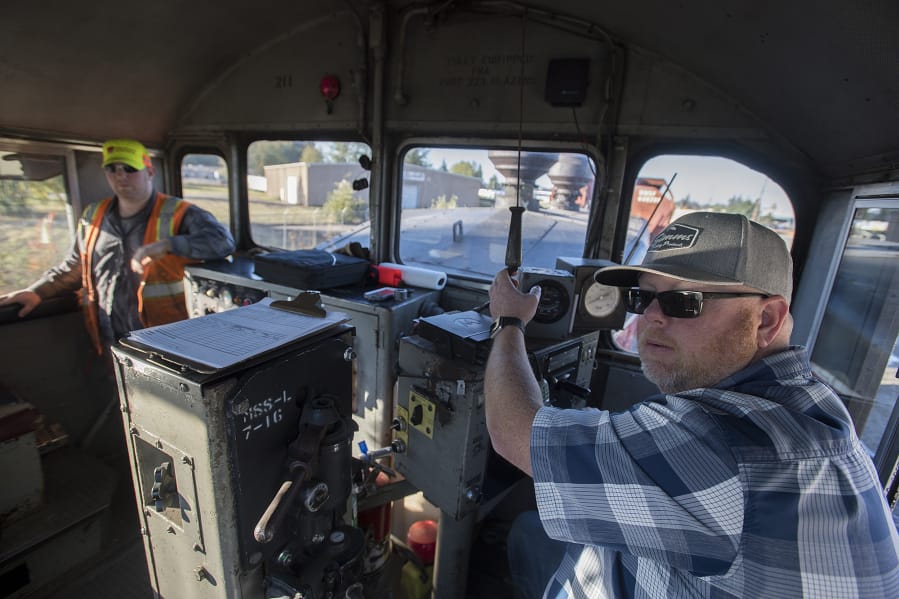On Nathan Bruce’s forearm reads a tattoo, “Not all who wander are lost.”
The 42-year-old has bounced around the nation working various railroading jobs, working the long days and nights required of the transient railroader lifestyle.
But he thinks he’s found his calling as the general manager of the Portland Vancouver Junction Railroad, which he calls the “Holy Grail” of railroading jobs.
He’s responsible for a portion of the short line railroad that stretches only 14 miles between Battle Ground and Vancouver. Owned by Clark County, the other segment is leased to BYCX, which operates the Chelatchie Prairie Railroad — a seasonal excursion passenger train.
On a recent Wednesday morning, he and two employees were working at the Rye rail yard along Northeast Saint Johns Road to move three empty railcars to another set of tracks. The day prior, the cars were emptied by nearby Omega Industries, which specializes in railroad material, including track products and steel fabrication. Rail switching is a routine part of the job; the train cars have to be moved so they can make their way to another location and be used again to haul more material.
“We’re fixed to the rail, so anywhere we came out of with cars, in order to get them to another location, we have to switch them over to another track,” Bruce explained.
Growing business
Small but mighty, the Portland Vancouver Junction Railroad routinely serves about seven customers along the line — at most a dozen, though they’re hopeful for more freight-dependent business along the line. Owner Eric Temple said in 2017 they moved 850 railcars, up from 43 railcars in 2003.
Last year, the Legislature amended the Growth Management Act to allow more freight rail-dependent uses on land parcels adjacent to the road. The public process is ongoing, though with some resistance from the nearby community.
“My hope and goal as the general manager of the operation is to grow the business,” Bruce said, as he navigated the cars a short distance and blew the familiar train horn “two longs, a short and a long” to alert any passersby that the train was about to cross the road.
They’re one artery of the larger BNSF web of rail, supplying Clark County businesses with the materials they need to produce whatever they’re making. For instance, Andersen Dairy in Battle Ground, the last stop on their line, needs plastic pellets to create their milk cartons. Or, there’s Canfield Transfer, at 9505 N.E. 62nd Ave., which is their most frequent customer. A loading, trucking and warehousing company, it receives materials about four to five times a week.
The Rye junction is where they interchange with BNSF. That morning, they didn’t have any arrivals, but the day before, BNSF alerted Portland Vancouver Junction Railroad of the Omega shipment via computer.
“So they could be coming all the way from Florida or Spokane — just wherever they buy the product at. Then they ship it to us. We’re the final destination for their specific product. They’re just one of a number of customers that we have on the line,” he said.
The morning starts with a check of the train, a mandate by the Federal Railroad Administration. The circa-1965 SW1200-model locomotive gets the job done each day, despite being “antique.” It’s about how well you care for the machinery, Bruce said.
A family of railroaders
Bruce started his life of railroading promptly at 18. He said dad was a manager at the then-Southern Pacific Railroad in Los Angeles. (It was acquired by Union Pacific in 1995).
“I turned 18 Aug. 1, and went to work for the railroad on Aug. 20,” Bruce, now 42, said. “Between cousins, uncles, my dad, my step-mom, there were 10 of us that worked for the railroad at one time. For me it was kind of the path of least resistance. Right out of high school, thankfully, I had pretty good earning potential based on a little bit of nepotism.”
He said that with a bit of a laugh, but added in a more serious tone: “I mean it’s a hard industry and you earn a reputation out here. The fact that your dad got you a job doesn’t mean you’re going keep the job. There’s a long line of folks that come into the business and it’s not for them or they just don’t pick it up. I took to it very quickly.”
These days, Bruce gets to do what he loves Monday through Friday, a regular schedule, which gives him the ability to possess a quality of life that he had not experienced during the previous 20-plus years working in the railroad industry, including many years with the Union Pacific.
The job is certainly a far cry from his last gig at Montana Rail Link. There, he endured hard winters living in Bozeman, Mont., North of Yellowstone National Park. He oversaw a territory of rail line 200 miles long, managed 400 to 500 employees and was on call constantly.
“It was a grind,” he said. After working there for four years, he returned to the Pacific Northwest in May. He had previously worked in Seattle in the late 1990s for four years. He “bounced around,” he said, always with a desire to make it back to the region.
Temple was looking for a new general manager after two people had retired last year. The job notice was up only a few days and attracted around 20 applicants, he said.
Bruce stood out.
“Safety is my biggest concern. The fact that he used to be a Union Pacific rules instructor — we’re a small railroad with limited resources. And for Union Pacific to bless someone to be their rules instructor, they don’t do that for just anyone.”
Bruce said Union Pacific paid him to fly around the country for three years and teach budding railroaders the ropes.
The last stop
Now, he’s working on teaching himself more about the management side of things. Though he still gets to satisfy his inner-child each morning, hopping on a train and blaring the horn, while spending the second part of the day tending to managerial tasks. He said he’s pursuing an online business degree through Arizona State University.
And what Bruce likes about the smaller operation, is that despite it being smaller, he is learning much more about the larger picture of railroad operation since he has to wear a lot of hats with a small staff.
As larger railroads such as Union Pacific and BNSF lose interest in dealing with the local deliveries, Bruce said, more short line and regional railroads are being depended on around the country. According to the Association of American Railroads, short lines such as the Portland Vancouver Junction Railroad account for 31 percent of U.S. freight rail mileage and 10 percent of employees.
Bruce, who lives in Camas, is happy with where he’s landed as he adjusts to the more intimate workplace and community.
“Hopefully this is the last stop. That’s my plan,” he said.




